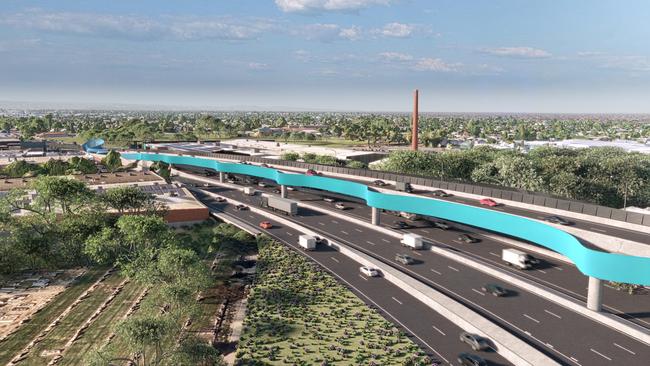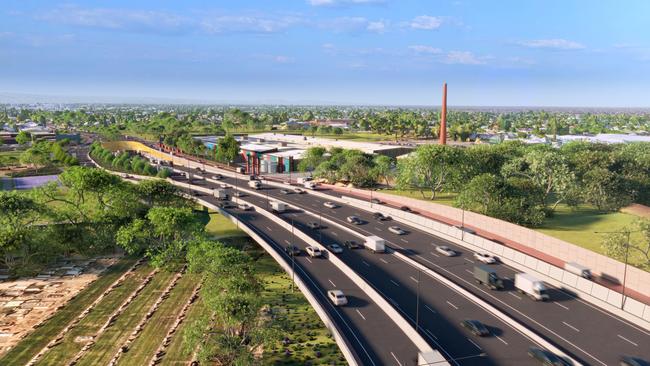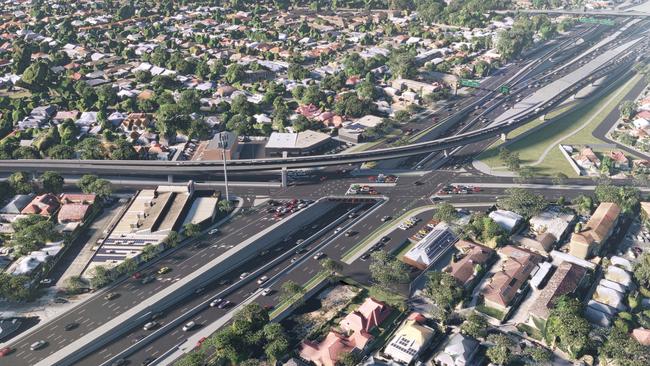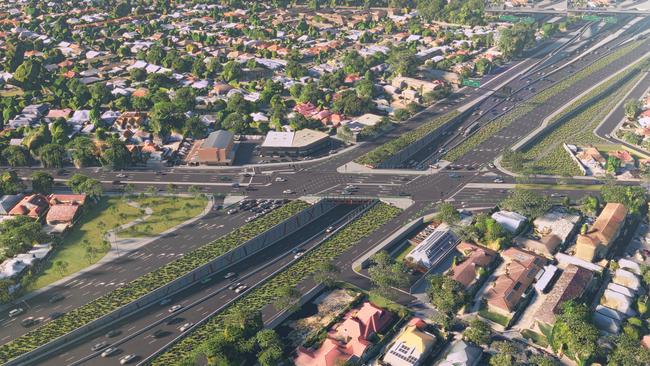New South Rd designs ditch ‘blue snake’ elevated roadway for Brickworks
The historic Brickworks Marketplace shopping centre has been spared from a huge blue snakelike structure soaring above it in the new South Rd designs.
SA News
Don't miss out on the headlines from SA News. Followed categories will be added to My News.
The Brickworks Marketplace shopping centre in Torrensville has been spared from a blue snakelike structure soaring 12m to the east as part of an elevated roadway, in the new South Rd designs.
Updated North-South corridor designs show the removal of the raised road, which featured a blue ribbon-like structure snaking along its eastern flank.
The motorway’s realignment to the east has allowed removal of the elevated structure next to the Brickworks, at the northern tunnel’s northern portal.
Most or all of the historic shopping centre would have been acquired under two shallow-tunnel options that were considered for the taking the motorway under the River Torrens. Both options would have cost between $500m and $1bn extra.


Nine-month road block out of the way
The new Torrens to Darlington plans will eliminate the need for a prolonged closure of the Darlington motorway because of changes made to the southern end of the design.
Transport Minister Tom Koutsantonis said he was advised by the Transport Department that the original design was “unbuildable”, given the proximity of the tunnel entrance to the northern part of the Darlington motorway.
“They also advised me that, if they built the steep ascent of that southern portal at that point, would have to close the Darlington motorway for up to nine months,” he said.
“So you imagine the entire North-South Corridor grinding to a halt, what that would have done to the grid network and the rest of South Australia for nearly a year while we were building a tunnel entrance that was dangerous.”
His other concern with the location of the original southern entry point was around the safety of motorists because of the short distance that cars would have to enter the tunnel or remain at-grade.
In response, the new design has shifted the southern entrance 300m to the north, allowing motorists travelling northbound from the Darlington motorway more time to make their selection.
The government has also committed to working with local councils and communities on local area traffic management during the project, Mr Koutsantonis said.
This will minimise potential impacts across the community throughout the construction period and after completion, and enable pedestrians and cyclists as much access as possible.
Long and short of new South Rd traffic
Travel times between the River Torrens and Darlington will be slashed to nine minutes when the final stage of the North-South Corridor opens to traffic in 2031.
Currently, drivers making the journey along South Rd in peak hour traffic can expect it to take 40-50 minutes. The current average travel speed on the stretch is 20km/h. On project completion, 30-40 minutes will be saved at peak time.
There are more than 200,000 vehicles that currently experience delays on South Rd and its east-west intersections every day, and forecasts show that traffic congestion is increasing.
Transport Minister Tom Koutsantonis said the road had been designed with future issues in mind.
“We’ve come up with the right plan, a plan that will last over 100 years,” he said.
“This is a road that our grandchildren will be using, this is a road that will outlast all of us and we’ve got to get it right.
“We’re the last city on the mainland still operating a grid, and the grid is failing.”
The previous Liberal government’s plan had also projected a nine-minute travel time once the Torrens to Darlington stretch was completed.


Historic cemetery lives on
One of the state’s oldest cemeteries has been spared in updated plans for the $15.4bn River Torrens to Darlington road project.
Hindmarsh Cemetery, on the corner of Adam St and South Rd, will not be disturbed, although a “low-height structure” will be constructed over the southwestern corner for the roadway.
The cemetery, on the River Torrens’ northern banks, was first used for a burial on April 21, 1846 – a decade after European settlement.
A revised layout has been designed to minimise the visual impact. Access to the cemetery will not be affected, nor will any plots within the grounds be disturbed.




